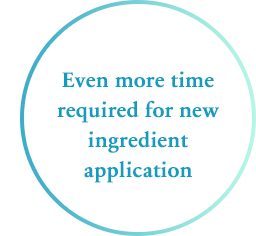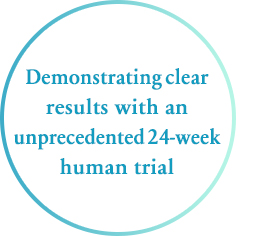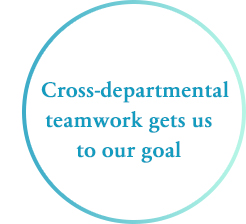- Suntory Global Innovation Center
- > Research & Technology
- > The Tokucha Development Story
- > Chapter 4-3. The long road from FOSHU application to approval
Research & Technology

Though we had all of this accumulated efficacy and safety data in hand when we submitted our FOSHU application for a beverage containing quercetin glycosides it still took an incredibly long time to get it to go through—five years from start to finish. The Japanese Ministry of Health, Labour and Welfare was in charge of our application we initially made it, but by the time it was granted, certification came from the Consumer Affairs Agency!


There’s no getting around the fact that new ingredients and new health claims must undergo a particularly rigorous investigation—and this naturally takes time. The process takes place in three stages: efficacy is the first thing discussed once an application is submitted, followed by safety, and then finally an overall decision is made. Experts from a variety of fields are called in to investigate at each step. Any expert is endlessly fascinated by the prospect of a new ingredient. We were asked a lot of questions.
But because we couldn’t sit in on the deliberations, all of the inquiries came to us in written form. Naturally this is a bit different than handling questions in person, and takes quite a bit of time. The reports we submitted in response to these inquiries ended up filling three 10-cm binders.
The most difficult question we were asked was, “If people keep consuming this ingredient, will they just keep losing weight?” Obviously body fat was never going to fall to zero, but proving that was surprisingly difficult. A typical product seeking FOSHU certification is evaluated using a 12-week human study, but we decided to do a 24-week study in order to answer this question.
We figured that customers would probably ask us this question anyway once the product was on the market, so we felt it was a good idea to go ahead and lay the groundwork that would allow us to provide them with a solid answer. We also knew that our product was likely to become a major seller once it hit the shelves, so even if this wasn’t a study that we would normally invest that kind of time and money in, we were confident that it would yield valuable data that could be used to demonstrate efficacy farther down the road. There were plenty of convincing reasons why we should do the trials, but it took six months of just having participants drink the beverages; it was nearly a year before we were able to reach any solid conclusions.

When we’re preparing to launch a product, it’s typically the marketing department pushing everyone to go as quickly as possible—and they were certainly rushing us ahead with this project as well. But we couldn’t sell it as a FOSHU product without going through the review process, so we explained that the study was absolutely essential to doing that. Because we were able to effectively work as a team with the marketing group, they ended up wholeheartedly agreeing with us and getting on board with our plan.
There were so many people involved in this project. The FOSHU application requires also submitting a design and product name as well as running production tests to make sure that we can actually manufacture something with the given specifications. We had to actually come up with a product design and build a production line for a product that we had no idea when we would be able to sell.
This meant that we had to secure the cooperation not only from the research side of things, but also from marketing, design, production, and other departments as well. The success of Tokucha is due to the fact that all of these different people from different parts of the company came together and gave their all as a team.
As it turned out, right before Tokucha hit the shelves, I was away from the company on maternity leave—and my baby ended up being born on the same day that the product was released. You can imagine my joy in receiving two of the most amazing gifts in my life at the same time!


* The department name, title, and photo are as of the time of the production (interview).
* The department name, title, and photo are as of the time of the production (interview).










